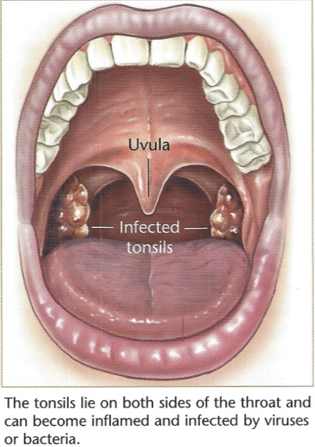A Guide to Tonsil Removal Surgery
Get Relief from Tonsillitis
What are tonsils?
They are a collection of cells at the back of your throat that are responsible for fighting infection. They detect and fight bacteria, viruses, and other organisms in the mouth and throat region.
They typically shrink as a child becomes an adult.

What are the adenoids?
When researching tonsillectomy, you’ll often hear about the adenoids. The adenoids are similar to tonsils. They are also a collection of cells, in the back of the throat, that are responsible for fighting infections.
What problems can tonsils cause?
Tonsillitis: Although tonsils are supposed to fight infection, sometimes, they do the exact opposite and cause repeated infections!
Inflammation of the tonsils is called tonsillitis, and it’s usually caused by an infection.
Some signs and symptoms of tonsillitis include:
- Sore throat
- Difficulty swallowing
- Fever
- Bad breath
- Swollen neck glands
- A general feeling of being unwell and tired
The tonsils may also be swollen, red, and may have yellow pus on them.
Almost everyone gets tonsillitis at some time. It’s when it’s happening repeatedly, and affecting someone’s quality of life, that it might be time for surgery.
Trouble Breathing: If the tonsils are too large, or get in the way, they can cause problems with breathing. This can be a very important problem to address, especially for children!
Some signs and symptoms that your child may have trouble breathing include:
- Snoring, often loudly
- Breathing that stops or pauses during sleep
- Loud snorting during sleep
- Gasping for air during sleep
- Sleeping with their head tilted back and breathing with an open mouth
Sometimes there can also be: bedwetting, slow growth, bad temper, headache, poor concentration, and general tiredness during the day.
Your child may have a sleep study done to see if sleep is actually being impacted. This is an overnight study that measures the amount of oxygen in the blood during sleep.
When enlarged tonsils start to impact sleep, such as snoring and sleep apneoa, it is a significant health problem. For example, sleep apneoa has been shown to cause high blood pressure, shorten life expectancy, and cause other diseases.
Other problems: There are also other rare problems of the tonsils, like an abscess.
What are the benefits of a tonsillectomy?
The tonsils will be removed. So, if the tonsils were causing recurrent bouts of tonsillitis, those bouts will no longer occur. If the tonsils were interrupting breathing and sleep, then those symptoms will be improved.
After healing is complete (which often takes about 1 to 2 weeks) most patients find their symptoms are greatly improved.
It is important to know that after a tonsillectomy you can still get the typical sore throat that happens with the common cold. A tonsillectomy only prevents the sore throat that comes from tonsillitis.
What is a tonsillectomy?
The goal of surgery is to remove the tonsils.
When the tonsils are removed the immune system is still able to work properly. In fact, many people have an improved immune system when diseased tonsils are removed.
It is performed through the mouth and there are no cuts on the surface. The patient will have a general anesthetic. This means that they are completely asleep and unaware. Usually they will need to stay overnight for this surgery.
As with any surgery there are risks involved, you need to discuss these with your surgeon and healthcare team.
What is an adenoidectomy?
The adenoids can cause similar problems to the tonsils. An adenoidectomy is a surgery where just the adenoids are removed. Click here to learn more about adenoid removal surgery.
What is an adenotonsillectomy?
This is a surgery where the adenoids and tonsils are removed during the same procedure.
What are the different tonsillectomy techniques? What are the important differences?
Cold Steel
- What is it? It involves non-powered instruments (e.g. instruments made of steel that don’t produce heat).
- It’s been around the longest of any of these techniques.
- Pros: No heat energy is transferred to the tissues, there is often less pain, and there’s a lower delayed bleeding rate (delayed bleeding rate is bleeding that occurs days to weeks after surgery).
- Cons: It takes more time to perform and there’s a higher initial bleed rate (initial bleed rate is bleeding that happens during or right after surgery).
Diathermy Tonsillectomy
- What is it? Hot electric instruments are used to cauterise the tissue between the tonsils and throat, this is to remove the tonsils and seal blood vessels.
- Pros: Widely available, fast (less time with the patient asleep), and a lower initial bleeding rate.
- Cons: Slightly higher delayed bleeding rate, tissue energy transfer during the procedure can cause more pain after surgery, and there’s a slightly higher risk of scarring.
Coblation
- What is it? A warm electric instrument that creates a plasma field to coagulate tissue between tonsil and the throat to remove the tonsils and seal blood vessels.
- Pros: There’s less heat energy transfer to the tissue and therefore less post-op pain, and also less risk of scarring.
- Cons: It takes slightly longer than some other techniques and it’s slightly more expensive.
ENT-ceps
- What is it? A fine hot wire forceps is used to cut the tissue between the tonsil and throat to remove the tonsils. No electricity is passed through tissues.
- Pros: There’s less heat energy transfer to the tissue and therefore less post-op pain, and also less risk of scarring. It’s also very precise.
- Cons: Slightly slower procedure and therefore more time asleep. For most surgeons, it takes longer to learn this procedure.
Bizact
- What is it? A new procedure that may prove to be more effective and safe than previous techniques.
- Pros: There’s less bleeding, minimal tissue damage, and less pain
- Cons: Expensive and not widely available.
Choosing the technique that is best for you depends on your preferences, your surgeon’s recommendations, and the location of your surgery. No one technique is perfect and there are advantages and disadvantages to each.
Do I need surgery on my tonsils?
You will need to see a registered healthcare professional to know if surgery is the best option for you.
Your doctor or surgeon may decide that antibiotics should be used before resorting to surgery. Antibiotics can be used instead of surgery when the infection is caused by bacteria and not viruses. This is because antibiotics only work on bacteria.
Surgery is often considered if:
- There have been many episodes of tonsillitis. For example, 8 or more in one year.
- There is scarring of the tonsils, this means that future cases of tonsillitis are more likely.
- There is a disruption in sleeping. Especially if oxygen levels in the blood drop overnight.
- There is difficulty swallowing.
- There are associated middle ear infections.
- In the case of children, if there is poor growth or weight gain.
There are also other factors to consider. For example, a problem with the adenoids as well may mean an adenoidectomy or adenotonsillectomy is recommended.
Surgery can also be delayed for various reasons. For example, in the case of specific other medical conditions, such as heart disease or bleeding disorders.
What if I choose not to have surgery?
This needs to be discussed with your registered healthcare provider.
Avoiding this surgery could mean that tonsillitis keeps occurring, or there continues to be trouble breathing and sleeping. Symptoms may worsen and disruptive sleep has been proven to be detrimental to many areas of health.
If tonsillitis keeps occurring, this can cause an abscess in the back of the throat. This would then require another procedure to drain the abscess.
Surgery is typically recommended because it’s considered effective and safe. However, in some cases a long treatment of antibiotics can stop the repetitive cycle of tonsillitis, and in some people after a few years tonsillitis stops being a problem.
How do I decide if surgery is right for me?
The decision to have surgery should only be made after consulting with a registered surgeon. The surgeon should be able to discuss the benefits, risks, and answer all of your questions to your satisfaction.
Before surgery your surgeon should ask you to sign a consent form. This form will help you understand the risks, you should read it carefully and ask your surgeon if you have any more questions. To learn more about some of the risks involved, refer to the section about complications and risks below.
What is recovery like?
Usually you will stay overnight and be sent home the next morning. Sometimes you will need to stay another day in hospital. For example, if your experiencing a lot of pain or your oxygen levels are low.
Some pain is common after the procedure. Rarely, people will say that the pain is severe. Strong painkillers can help during recovery and typically should be taken for about a week after surgery. Often the pain is worse about 7 - 10 days after surgery and then it starts to get better.
Adults can typically be back at work after 2 weeks.
Children can typically be back at school after 2 weeks.
There is a chance that during the recovery period you will have some bleeding from the surgical site. If this happens you may have to return to hospital, you may be given antibiotics and fluids, and very rarely may need another surgery.
What are the risks of tonsillectomy?
At Melbourne ENT Group, we ensure that the operation is as safe as possible. But, as with any surgery complications can occur and some of these can be serious and can even cause death. Any numbers relating to risk describe how often a particular complication occurs in people having this operation. Your surgeon may be able to tell you if the risk of a complication is higher or lower for you. There may be risks that you are particularly concerned about. If they haven’t been discussed then please mention them to us.
Complications specific to this surgery include:
- Tonsil remnants: Small pieces of the tonsil can be left behind after surgery. This can continue to cause infections.
- Lingual tonsillitis: There are some tonsil cells in the back of the tongue. These are not removed and can continue to still cause tonsillitis symptoms.
- Feeling something in the back of the throat: Some people (about 1 in 5) will have the sensation that there is something in the back of their throat.
- Change of taste: About 1 in 3 experience this in the first two weeks after surgery, about 1 in 12 for 6 months after surgery, and about 1 in 100 for 2 years after surgery.
General surgical complications:
Whenever an incision is made in the body, there is a risk of pain, bleeding, infection and scarring. We will minimise these risks in various ways.
- Pain: Common after tonsillectomy. Pain medication is given to reduce pain.
- Bleeding: If bleeding is heavy you may need a blood transfusion or another procedure to stop the bleeding.
- Risk of significant bleeding during surgery is less than 1 in 100, bleeding within two weeks is less than 6 in 100.
- Infection: If it occurs, this can usually be treated with antibiotics but in rare cases requires another procedure.
Anaesthetic complications:
Modern anaesthetic techniques are generally very safe, and precautions minimise the chance of any complications occurring. However, an anaesthetic can put a stress on your organs such as your heart, lungs, liver and kidneys. Your anaesthetist will be able to discuss with you in detail any of the possible complications of having an anaesthetic.
Summary:
For the right patient, a tonsillectomy can be a great option for two reasons:
1 - To reduce recurring bouts of tonsillitis, and/or,
2 - To Improve breathing and quality of sleep.
Surgery is usually safe and effective but complications can happen. You need to know about these risks to help you to make an informed decision about surgery. Knowing about them will also help to detect and treat any problems early.


